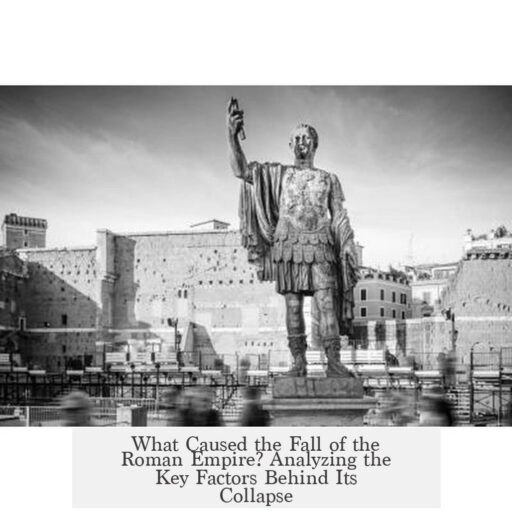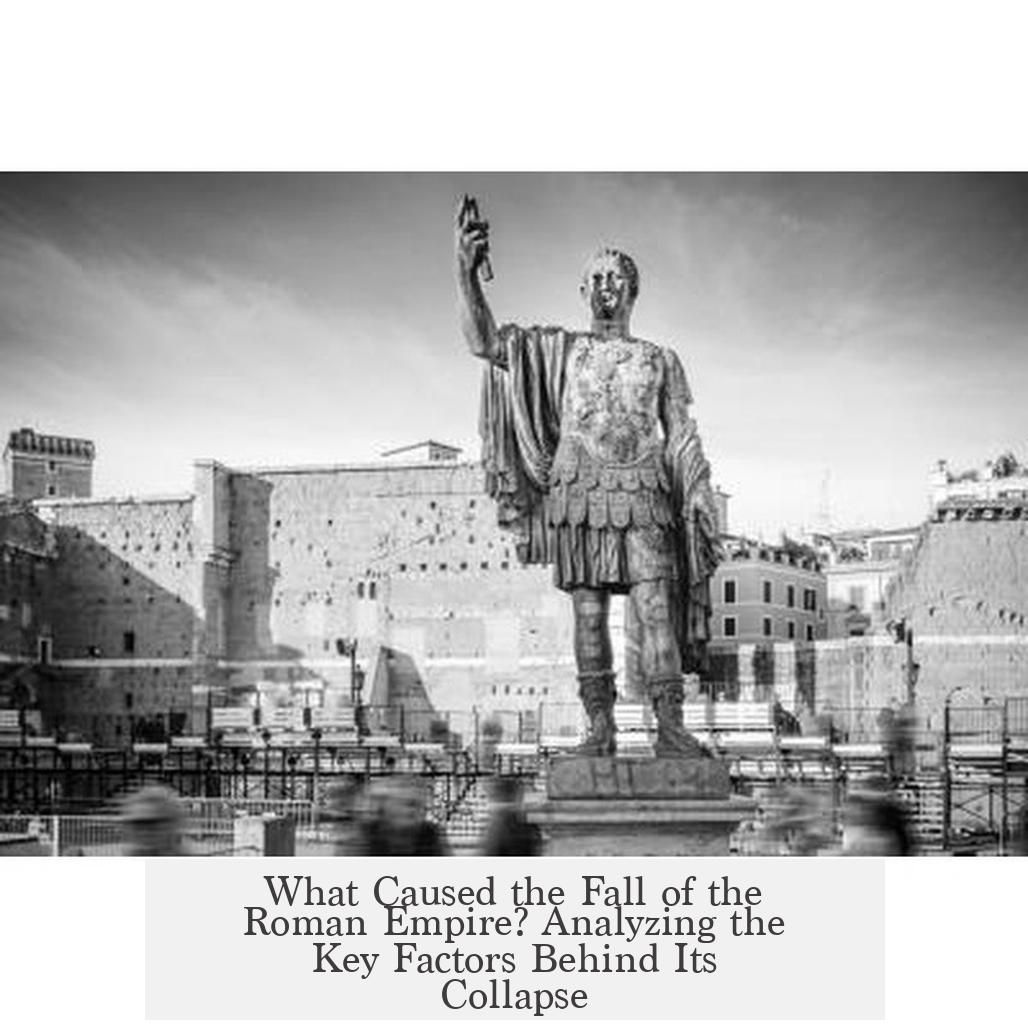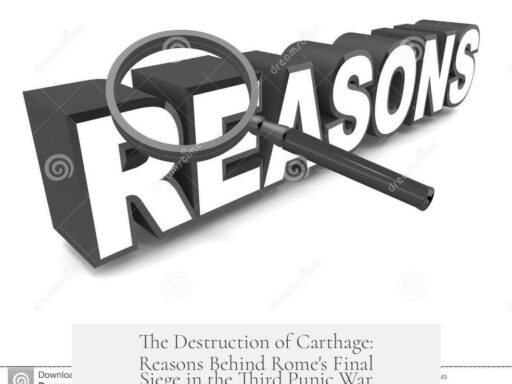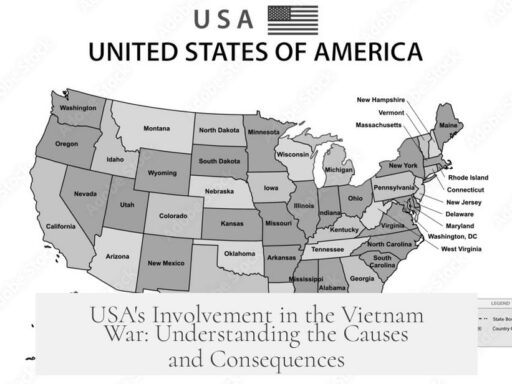The largest factor contributing to the fall of the Roman Empire was its persistent internal conflict and civil wars, rooted in a failure to establish stable succession and centralized political control. This chronic internal strife gravely weakened the empire, making it vulnerable to external pressures, economic decline, and social fragmentation.
The Roman Empire’s political system lacked a clear process for peaceful transfer of power. After Emperor Marcus Aurelius, the absence of a defined succession plan caused constant rivalries and power struggles. This instability triggered a series of civil wars, especially pronounced during the “Crisis of the Third Century” (235-284 AD), a fifty-year period when the empire fractured into three competing states. Such infighting drained resources, devastated infrastructure, and disrupted governance.
This internal turmoil forced emperors and generals to focus on fighting rivals rather than defending borders or managing the empire effectively. The empire’s vast size made it difficult for imperial forces to respond quickly. Usurpers and competing factions could seize power by mobilizing local legions with more loyalty to their commanders than to Rome itself.
Several historians emphasize that these civil wars and political assassinations throughout the 3rd and 4th centuries destabilized the empire to a degree that could have led to collapse independently of external threats. The inability to create a stable dynastic succession turned military force into the sole arbiter of political power, undermining long-term state cohesion.
This internal instability interplayed with other factors, but it remained the root cause. For example:
- Erosion of Loyalty: Border legions and auxiliary troops increasingly identified with local leaders or ethnic groups rather than the empire. Many soldiers were Germanic mercenaries whose allegiance was transactional, weakening imperial unity.
- Economic Decentralization: The rise of the ‘villa system’ meant that many local economies became self-sufficient and tax revenues declined. This weakened central authority, making it harder to fund the military and administration.
- Financial Strain: Constant wars drained the imperial treasury. The military budget was under extreme pressure, especially along the Rhine frontier, where migrating peoples threatened the border repeatedly.
- Population Movements: Migrating tribes such as the Germanic peoples and the Huns pushed into imperial territories. Their settlements inside the empire often came with autonomy and divided loyalties, complicating imperial control.
- Disease and Climate Change: Pandemics and shifting climate patterns reduced the population and agricultural productivity, shrinking the pool of manpower for legions and hurting tax income.
The ongoing civil wars significantly exacerbated these other issues. For example, the resources wasted on internal conflicts reduced the empire’s ability to respond to external migration and invasion pressures. The failure of the political system to prevent violent successions contributed to corruption and local political fragmentation.
Efforts to stabilize the empire, such as reforms by emperors Diocletian and Constantine, temporarily strengthened central authority. Diocletian enlarged the army and restructured governance, and Constantine moved the capital to Constantinople to better manage the eastern provinces. Yet, these measures could not fully overcome the empire’s foundational weaknesses.
In contrast, external pressures such as invasions by migrating tribes during the Migration Period were significant but often consequences of Rome’s own weaknesses. Economically and militarily weakened by civil wars and decentralization, Rome could not effectively repel escalating incursions.
Ultimately, this internal chaos shaped the empire’s decline more fundamentally than any single external factor. While pandemics, economic shifts, and invasions played vital roles, they exploited the fault lines created by relentless civil wars and political instability.
Key takeaways:
- Rome’s lack of a stable succession system caused repeated civil wars and internal conflict.
- Political instability drained resources and eroded loyalty among troops and provinces.
- Economic decentralization and villa system weakened central tax revenue and control.
- External invasions and migrations exploited Rome’s internal divisions and military weakness.
- Reforms improved stability but could not fix deep structural political problems.
- Internal conflict was the primary factor enabling Rome’s external and economic challenges to cause collapse.
What Really Crumbled the Roman Empire? Exploring the Largest Factor Behind Its Fall
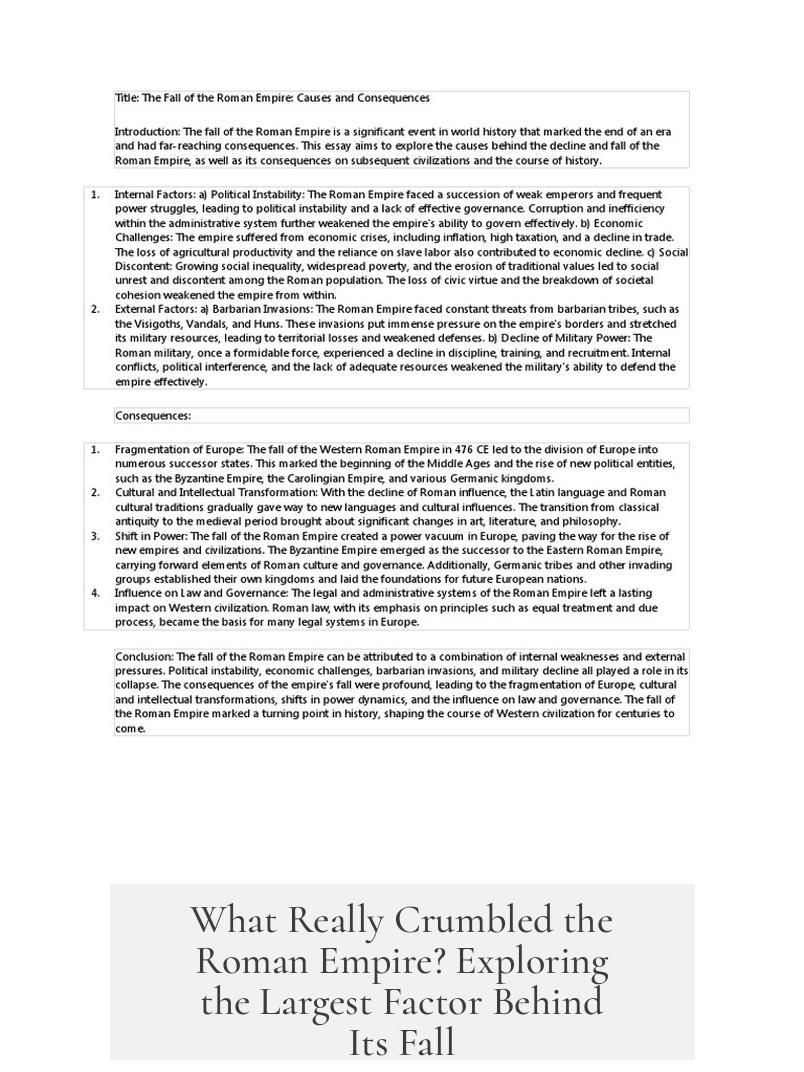
When we ask, “What is the largest factor that led to the fall of the Roman Empire?”, the quick answer is: it was a complex web of interconnected failures, but the relentless civil wars and political chaos stand out as the single biggest culprit. Sure, there’s more to the story, from migrating tribes to economic shifts, but dissecting this internal turmoil opens a clear window into how a superpower collapses from within.
Let’s dive deep and uncover why Rome’s internal fighting, or more simply put, Romans battling Romans, served as the fatal wound.
The Empire’s Civil Wars: A Self-Inflicted Wound
Rome’s glory was famously built on conquests, loot, and slaves. But the internal civil wars—where Romans fought each other—drained resources and morale like a leaky bucket with no patch in sight. After the peaceful reign of the Five Good Emperors, the assassination of Commodus plunged Rome into what historians call the Crisis of the Third Century: a fifty-year span of almost nonstop civil war that fractured the empire into three competing chunks.
Imagine being an emperor, hearing that someone on the other side of the empire just declared themselves “emperor” and sent an army your way. By the time you even found out, your empire’s integrity was already on shaky ground. The rate of rebellions and assassinations in the 3rd and 4th centuries was so absurdly high, managing borders and governing took a backseat to simply surviving yet another power struggle.
This chaos wasn’t a brief hiccup—it’s structural. There was no peaceful transfer of power. Instead, any general with a loyal legion and enough ambition could become “Caesar” by force and intrigue. No system existed to determine the next ruler, leading to endless war after emperor after emperor fell.
In fact, the constant civil wars alone could have doomed the Western Roman Empire. The Eastern Empire survived only because it reinforced a dynastic principle, essentially saying, “No more random generals declaring kingship—here’s the family line to follow.”
The Villa System: Economic Decentralization and a Fraying Web
While Rome was busy fighting itself, its economy was quietly unraveling. One critical change was the rise of the “villa system.” Entire towns became semi-self-sufficient units controlled by a wealthy landowner considered “family.” But these families weren’t relatives—they included slaves and serfs bound to the land legally. Because trade within these units was private and outside central taxation, Rome’s tax system dried up.
This was a massive blow. The empire’s strength came partly from a network of trade and tax revenues powering central control. When local “heads of families” took control of their domains economically and politically, the empire’s cohesion weakened. Instead of a tightly knit empire, Rome was a patchwork of semi-independent fiefdoms.
This fragmentation eroded central political control long before the empire officially collapsed. It’s like a giant clock losing its gears—everything technically exists, but the functioning becomes erratic.
Migrating Tribes and Shifting Loyalties
Adding to the empire’s internal chaos, great waves of migration shook its borders. Germanic tribes, fleeing from the Huns, moved westward and were settled within the empire’s border regions. Rome used these tribes as buffer forces—expecting them to defend the empire against other similar outsiders.
But here’s the kicker: these groups didn’t really owe loyalty to Rome. Their allegiance was transactional, based on mutual benefit or fear, not love for the empire. Over time, border legions identified more with their local groups than with Rome itself. Instead of defending a vast empire, they focused on local law and order.
Rome’s armies were increasingly manned by non-Roman auxiliaries, often Germanic warriors. In a twist of tragic irony, many of these auxiliaries eventually turned against Rome and sacked its cities, including Rome itself in 410 AD by the Visigoths.
Parasitic Financial Strains and Military Spending
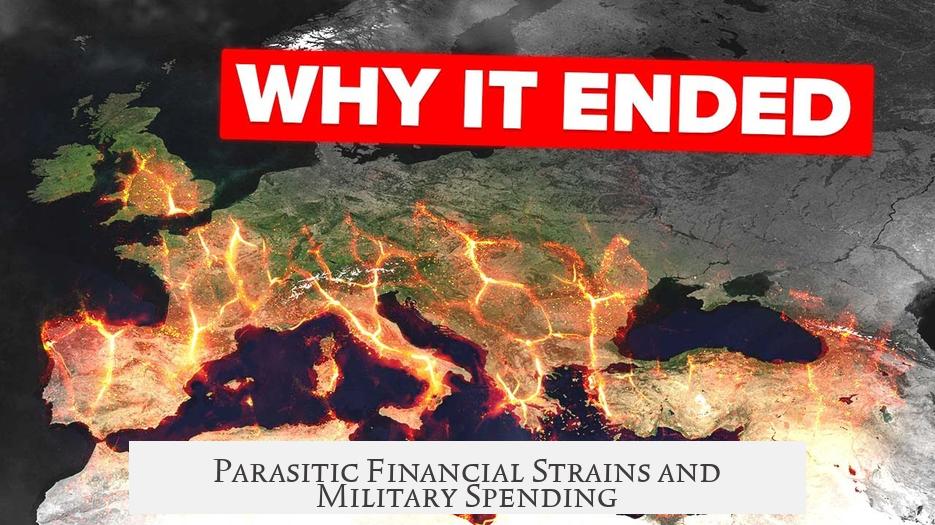
The empire was shoehorned into financial stress. Maintaining a giant army stretched across vast frontiers was expensive and unsustainable. Provinces like Gaul, Britain, and Hispania barely contributed enough tax revenue to maintain their borders during peaceful times, let alone during the chaos of the Migration Period.
By the 400s, pressure on the Rhine frontier exploded. Migration waves and invasions from Germanic tribes overwhelmed Roman defenses. Rome couldn’t raise enough funds or recruit enough manpower to defend itself effectively. The debt and constant military drain compounded economic decline.
The Unseen Enemies: Disease and Climate Change
Beyond wars and economics, invisible forces made Rome’s enemies appear larger and its defenses weaker. Pandemics first identified as significant by historian William McNeil hit the empire hard, drastically reducing populations. The book The Fate of Rome argues that pandemics and climate changes reduced the Mediterranean’s agricultural productivity, starving the empire of food and soldiers.
Climate shifts possibly made the Eurasian steppe more productive for nomadic tribes like the Huns, prompting them to move into Roman territory. So, Rome faced more pressure from external migrations driven by environmental changes it could neither control nor foresee.
Corruption and Political Turmoil: Rotten from the Inside
Rome’s political class was riddled with corruption. Power was up for sale, officials enriched themselves at the empire’s expense, and the governing elite often prioritized personal gain over public good. This widespread corruption weakened administrative systems and diverted vital resources.
Corruption also destabilized the empire, shaking citizens’ trust and political loyalty. When the empire needs unity, corruption tears it apart. Rome was stretched thin, relying more on Germanic auxiliaries and less on Roman citizens to maintain order, eroding the foundation of loyalty that once held it together.
Acknowledging the Elephant in the Room: Manpower and Loyalty Issues
Rome’s military traditionally avoided arming slaves or poor free citizens who weren’t full legionaries. Meanwhile, migrating tribes could muster huge armies of 20,000 to 500,000 soldiers. The manpower imbalance became a critical weakness.
Furthermore, many of Rome’s forces lacked real loyalty to Rome in its twilight years. The Roman identity was fading, replaced by cultural and regional loyalties. For several decades, Rome itself stopped being the empire’s heart—it was no longer the dominant city in Italy. The concept of being “Roman” was becoming more symbolic than practical.
The Sasanian Threat and Eastern Reforms
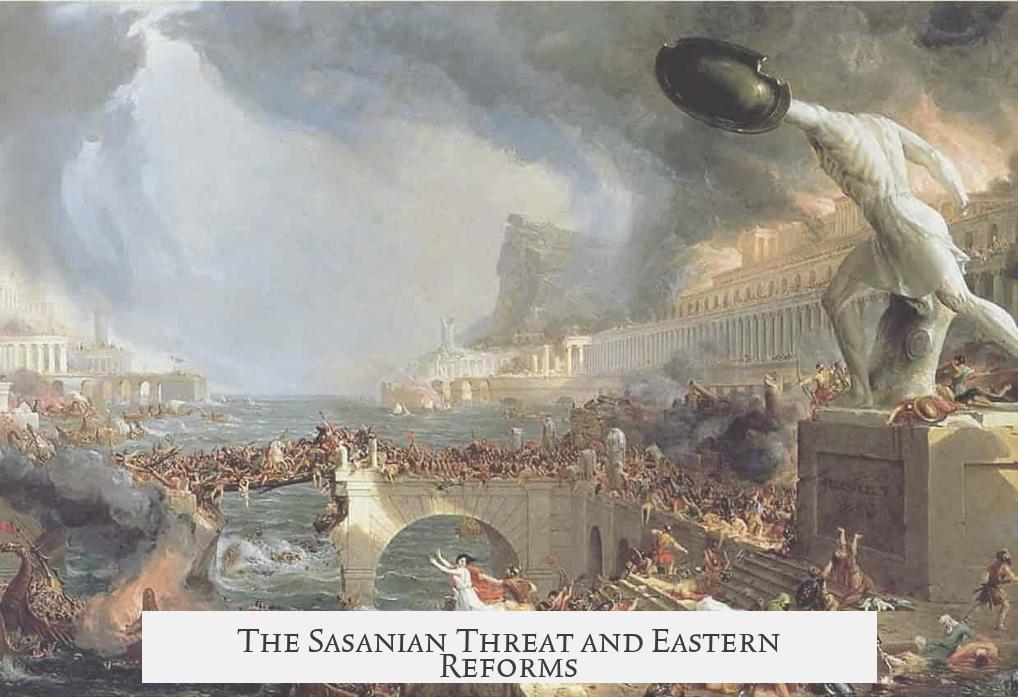
On the eastern front, the Sassanians presented a major threat. Emperors Diocletian and Constantine reformed the army and bureaucracy, moving the capital eastward—first to Nicomedia, then to Constantinople. They boosted taxes, army size, and embedded Christianity into state identity.
These reforms stabilized the Eastern Roman Empire but came too late and were insufficient to save the West. Despite temporarily neutralizing the Sasanian threat with a 387 AD peace treaty, the West faced irreparable damage—culminating in the sack of Rome by Vandals just 20 years later.
Was Stagnation the Death Knell?
Rome’s rapid expansion created a sprawling empire that became too large to govern effectively. Surrounding tribes were impoverished but populous, and Rome had few rich cities left to conquer. Without new wealth to plunder or new territories to control, the empire’s growth stalled.
Stagnation slowed innovation and economic vitality. The empire depended heavily on slavery for economic output. Once expansion halted, so did the influx of new slaves, and the economy’s engine sputtered. Slavery’s discouragement of innovation also hurt long-term economic growth, accelerating decline.
Wrapping It All Together: The Largest Factor?
With all these factors—economic shifts, migration, pandemics, border pressures, corruption, and climate change—why single out civil wars and political chaos? Because without a stable government and peaceful transfer of power, no system can survive. Rome’s political dysfunction undercut every other attempt to heal its problems.
The endless infighting sapped military strength, shattered economic cohesion, and destroyed the empire’s ability to respond to external threats. Other factors might have been manageable if a stable ruling system existed.
Rome’s failure to create a clear, peaceful system for leadership succession was a nail in the coffin. This breakdown unleashed waves of civil wars that hollowed out the empire from the inside. While foreign invasions and economic woes pressurized the empire, it was Rome’s own internal strife that made the collapse inevitable.
Lessons From Rome for Today’s Polities
What can modern states learn from this? Stability in leadership transitions is crucial. Economic cohesion is essential to support defense. Loyalty and unity, both cultural and political, must be reinforced to withstand external pressures.
Rome’s story reminds us that external threats can be catastrophic, but internal chaos is often the final blow. Empires don’t just fall to barbarians—they collapse from failing systems within.
Final Thoughts
So, while Migration, economic shifts, pandemics, and climate change all played critical roles, the largest factor for the fall of the Roman Empire is the relentless civil wars and political turmoil tearing the empire apart from within. Without internal peace and stable governance, Rome was a giant waiting to crumble.
Isn’t it ironic how Rome’s might—once enviable for millennia—fell because its leaders fought so much more fiercely against each other than any outside enemy? Maybe that’s a lesson just as timeless as Rome itself.
